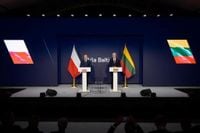On Monday, October 20, 2025, a ribbon-cutting ceremony at the border between Poland and Lithuania marked more than just the opening of a new stretch of road. The inauguration of Via Baltica—a major highway connecting Poland with the Baltic states of Lithuania, Latvia, and Estonia—comes at a time when nerves are frayed across Eastern Europe. With tensions between Europe and Russia simmering, the new route is being hailed as a lifeline for both economic growth and regional security.
Polish President Karol Nawrocki and Lithuanian President Gitanas Nausėda stood side by side at the border, underscoring the symbolic and strategic significance of the project. According to the Associated Press, Nawrocki declared, “This road has a dual purpose – it will help our economy and strengthen the defense capabilities of our region.” Nausėda echoed this sentiment, stating the road “symbolizes freedom, prosperity and security,” and plays an “extremely important economic, commercial, and logistical role in Lithuania, connecting us with the rest of the European market.”
The timing of Via Baltica’s opening is no accident. In recent months, Poland and its Baltic neighbors have been on high alert. September saw multiple Russian drones reportedly enter Polish airspace, while Russian fighter jets crossed into Estonia. The region is acutely aware of its vulnerabilities—especially the Suwalki Gap, a narrow corridor sandwiched between Belarus and Russia’s Kaliningrad exclave. This strip of land is often cited by military analysts as a potential flashpoint if Russia were to target NATO’s eastern flank. The new road passes directly through this strategic chokepoint, making its construction all the more significant.
Via Baltica is not just a local project. Stretching approximately 970 kilometers (600 miles), it starts in Warsaw and winds north through Lithuania, Latvia, and Estonia, finally reaching Tallinn. It forms part of the broader European route E67, which links Finland in the north to Czechia in the south. The four-lane A5 highway connecting Kaunas, Lithuania’s second-largest city, with Suwalki in Poland is a critical segment of this route. However, several sections northbound are still just two lanes, with Lithuania’s Ministry of Transportation promising future expansions to accommodate growing traffic and strategic needs.
Notes from Poland highlighted the dual nature of the project, quoting Nawrocki: “Via Baltica creates new opportunities for cooperation in terms of jobs and economic projects. [But] the connection we are officially opening today is much more than just another transport route for us, the nations of central Europe. It is a link that strengthens our relationships, brings our societies closer together, and contributes to the resilience of our region.” The Polish president also pointed to the deep historical ties between Poland and Lithuania—two countries that for centuries formed a joint commonwealth—saying the road has a “symbolic dimension, uniting two nations with a shared, glorious history and common values…[of] sovereignty, freedom, mutual respect and solidarity.”
For President Nausėda, the new highway is a testament to “centuries of trust and unity between our nations,” and he emphasized its role in “strengthening Europe’s security and resilience.” The Lithuanian leader also noted, as reported by Lithuanian public broadcaster LRT, that thanks to Via Baltica, “You can now reach Warsaw in about four and a half to five hours. That would have been unimaginable 20 or 25 years ago, when the trip took nearly two days.”
The economic implications are vast. With upgraded infrastructure, it is now possible to travel from Lithuania to Lisbon, Portugal, entirely on highways—a feat that seemed unlikely just a generation ago. The Polish section of Via Baltica alone took more than a decade to complete and cost over 11 billion zlotys (€2.6 billion), with nearly €1 billion supplied by European Union funds, according to Euronews. These investments are expected to pay dividends, not just in smoother logistics but also in attracting new business and fostering cross-border cooperation.
Yet it’s the road’s military and defense significance that has drawn the most attention. NATO officials see Via Baltica as a critical artery for rapid troop movement in the event of a crisis. Nawrocki’s office noted that the route “significantly improves the alliance’s military transport capabilities and the potential rapid deployment of military units in the Baltic states.” The region’s strategic importance is further underscored by the fact that, as Notes from Poland reported, NATO’s five biggest defense spenders this year (as a proportion of GDP) are Poland, Lithuania, Latvia, Estonia, and Norway—a clear sign of the region’s acute awareness of the Russian threat.
The opening of Via Baltica is only one piece of a larger puzzle. The Baltic states have recently severed their electricity links to Russia’s grid, connecting instead to the EU network via Poland—a move that further integrates the region with Western Europe and reduces dependence on Moscow. There’s also Rail Baltica, a companion railway project that began construction in 2019. Although beset by delays and ballooning costs (from an initial €6 billion to a staggering €24 billion), the railway aims to run from Tallinn to the Polish border, with the first sections expected to be operational by 2030.
Of course, not everything is rosy. Some sections of Via Baltica remain two lanes, and the railway project’s escalating costs have raised eyebrows in Brussels. The European Commission has expressed concerns about the quadrupling price tag, and disputes between Baltic governments over the railway’s routing have caused further delays. Still, the determination to press forward is palpable, driven by both practical needs and the shadow cast by Russia’s recent actions.
For many in the region, the opening of Via Baltica is a moment to celebrate progress and unity, but also a reminder of the challenges that remain. As President Nausėda posted on X, “Opening Via Baltica with President @NawrockiKn is not just about connecting two countries – it’s about strengthening Europe’s security and resilience. From energy and transport links to defence cooperation, Lithuania and Poland stand together – united by history, driven by common goals.”
With its asphalt now open to traffic, Via Baltica stands as both a symbol and a tool: a testament to the power of partnership in uncertain times, and a concrete step toward a safer, more connected Europe.


